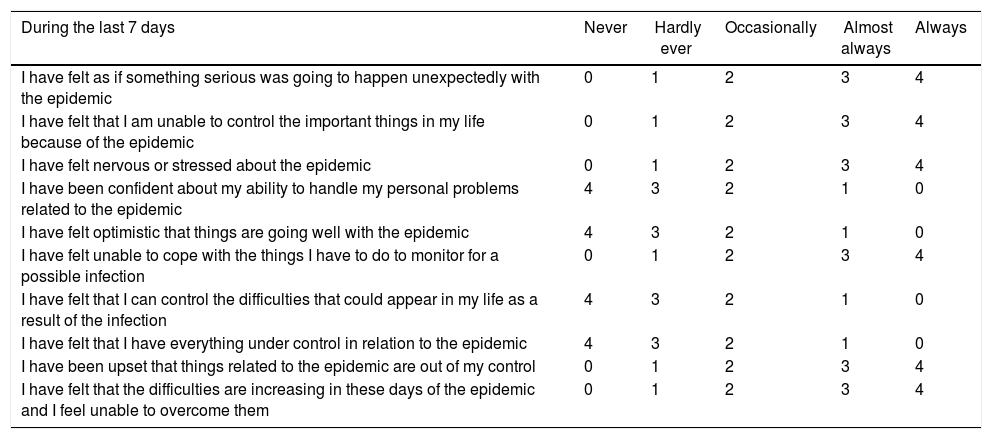In the global context, the coronavirus (COVID-19) pandemic represents a public health problem due not only to its physical impact, but also its effect on emotional well-being.1,2 The epidemic that started on 1 December 2019 in Wuhan, China, spread to several countries, including Colombia. By 16 March 2020, some municipal and departmental authorities took measures to restrict the mobility of citizens in the territories. Specifically, they implemented physical isolation, a quarantine, as a traditional public health measure in the face of easily transmitted infectious diseases.3
Given the need to learn the impact of these measures on the emotional well-being of citizens, it is necessary to have valid and reliable measurements, obtained remotely. There are some specific instruments to measure emotional well-being in quarantine situations, such as the Kessler Psychosocial Distress Scale (K10)4 and the COVID-19 Peritraumatic Distress Index (CPDI).3 However, information on the psychometric characteristics of these scales is very scarce. Therefore, it was necessary to explore the psychometric performance of some instruments to quantify the emotional well-being of Colombian citizens during the time their mobility was limited. The objective of this research was to calculate the internal consistency and to carry out an exploratory factor analysis (EFA) of a modified version of the 10-item Perceived Stress Scale (PSS-10).5
An online validation study was designed between 8:00 p.m. on 21 March and 8:00 p.m. on 23 March 2020. The modified version of the PSS-10 related to COVID-19 (PSS-10-C) was distributed to the people who gave their informed consent in the questionnaire they received via email, Facebook or WhatsApp. A total of 406 people between 19 and 88 (43.9 ± 12.4) years old participated. Of these, 61.8% were women, 90.6% had university degrees, and 44.1% were workers in the health sector.
The participants completed the PSS-10-C (Table 1). The PSS-10-C is made up of 10 items, each of which offers five response options: never, almost never, occasionally, almost always and always. Items 1, 2, 3, 6, 9 and 10 are scored directly from 0 to 4 and items 4, 5, 7 and 8, conversely, from 4 to 0. The PSS-10 was considered due to the acceptable internal consistency shown in other Colombian studies, with a Cronbach's alpha between 0.65 and 0.86.6,7 Internal consistency was calculated with Cronbach's alpha coefficient8 and the EFA, in which it was determined whether the items grouped a latent factor (Bartlett's Test of Sphericity and Kaiser-Meyer-Olkin [KMO] sample adequacy test) and the number of factors (with eigenvalue and explained variance). The analysis was performed using IBM-SPSS version 23.9
Items and way of scoring the PSS-10-C.
| During the last 7 days | Never | Hardly ever | Occasionally | Almost always | Always |
|---|---|---|---|---|---|
| I have felt as if something serious was going to happen unexpectedly with the epidemic | 0 | 1 | 2 | 3 | 4 |
| I have felt that I am unable to control the important things in my life because of the epidemic | 0 | 1 | 2 | 3 | 4 |
| I have felt nervous or stressed about the epidemic | 0 | 1 | 2 | 3 | 4 |
| I have been confident about my ability to handle my personal problems related to the epidemic | 4 | 3 | 2 | 1 | 0 |
| I have felt optimistic that things are going well with the epidemic | 4 | 3 | 2 | 1 | 0 |
| I have felt unable to cope with the things I have to do to monitor for a possible infection | 0 | 1 | 2 | 3 | 4 |
| I have felt that I can control the difficulties that could appear in my life as a result of the infection | 4 | 3 | 2 | 1 | 0 |
| I have felt that I have everything under control in relation to the epidemic | 4 | 3 | 2 | 1 | 0 |
| I have been upset that things related to the epidemic are out of my control | 0 | 1 | 2 | 3 | 4 |
| I have felt that the difficulties are increasing in these days of the epidemic and I feel unable to overcome them | 0 | 1 | 2 | 3 | 4 |
The PSS-10-C showed α = 0.86. In the EFA, the Bartlett test showed χ2 = 1,399.35; degrees of freedom = 54; P < .001 and KMO = 0.82. A single factor was identified, with an eigenvalue of 4.42, which explained 44.2% of the total variance. The observed scores were between 0 and 36 (16.5 ± 7.3); 58 people scored 25 or more.
These findings are encouraging, but the EFA data are somewhat different from those expected under ideal conditions: that the identified factor explains at least 50%.10 Some additional adjustments may need to be made to the wording of this version.11 However, it is proposed to use the cutoff point of ≥25 for COVID-19-related perceived high stress in the possible studies that are carried out at this juncture, and to have a similar measure of such stress in the Colombian population. In addition, it is important to test the performance of the PSS-10-C in other Colombian samples, given the variations that can be observed according to the characteristics of the population,12 and to carry out a confirmatory factor analysis when an EFA with better indicators is available.
Please cite this article as: Campo-Arias A, Pedrozo-Cortés MJ, Pedrozo-Pupo JC. Escala de estrés percibido relacionado con la pandemia de COVID-19: una exploración del desempeño psicométrico en línea. Rev Colomb Psiquiat. 2020;49:229–230.






